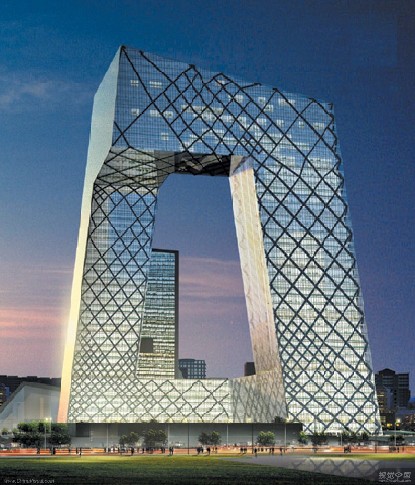CCTV's new HQ set to make mark
Updated: 2008-02-20 07:17
It is a building that could only have happened in China.
And for the man behind the new CCTV headquarters, the Beijing Olympics was the catalyst in a perfect mix of factors that led to one of the most ambitious structures in the world.
|
An artist's rendering of the new CCTV headquarters |
"There is probably nowhere else in the world that could have generated a project like this," Ole Scheeren, the German architect in charge of the building, told China Daily.
A partner of Dutch architect Rem Koolhaas at the Office for Metropolitan Architecture (OMA), Scheeren, 37, has led a team of almost 400 architects, designers and engineers over the past six years of the project.
Scheeren gave his assurance the building will be "visually complete" and "take its place in the city" in time for the Games.
He said architecture is all about timing - and the time was just right for him to take on the challenge when he started to work on the project's design in 2002.
"It was a very particular moment in history. Being awarded the 2008 Olympics exacerbated a lot of things that were already happening and really acted as a catalyst for a more focused moment of ambition."
With 475,000 sq m of gross floor area and a budget of $695 million, the new headquarters of the State broadcaster is said to be the world's second-largest office building after the Pentagon in the United States.
It has been designed in opposition to the traditional skyscraper, a "geometrically folded tube in space" that is already one of the most striking features of Beijing situated along the Third Ring Road in the heart of the new central business district.
The loop-like structure has been conceived as a unique building, housing all processes of television-making - broadcasting, program production, news studios, research and training, administration, as well as numerous recreational facilities and canteens for 10,000 staff at a time.
Features and facilities such as a media museum, media park, 1,500-seat theater, five-star hotel and digital cinemas - some housed in the adjacent Television Cultural Center or TVCC building - will also be open to visitors.
More intimately, the "Visitors' Loop", a pathway circulating through the main building, will offer a close-up view of the TV-making process.
"This project was formulated with the desire to have a lot of parts and pieces dedicated to the public," he said.
Unlike other iconic structures like the Bird's Nest and Water Cube, claiming their spot in the capital as the Olympics draws the world's attention to China, CCTV goes further.
"The CCTV building is really built for the future operations of one of the largest media organizations in the world with an enormous potential for development and growth," Scheeren said.
Singapore-based architect William Lim, 75, who with a group of Asian architects was given a tour of the CCTV building site last year by Scheeren, said projects like the CCTV one marked a significant point for architecture in China.
"These actually become a stimulant for local architecture; they are entering the international architectural conversation talking to each other across the globe," Lim said.
Scheeren added that a crucial part of the project's role and contribution lay within the dialogue in his international and Chinese team.
"The idea of collaboration was important to us, and we put a lot of effort into shaping a process that would root the project in a shared space between both cultures," he said.
|
|
|
||
|
||
|
|
|
|
